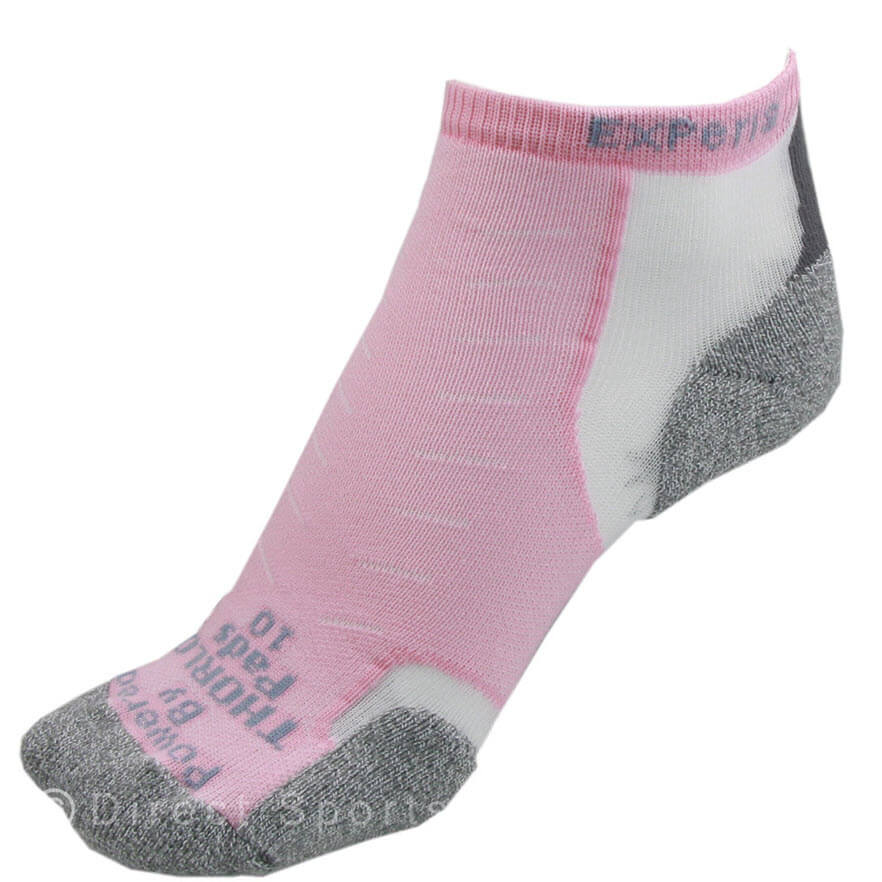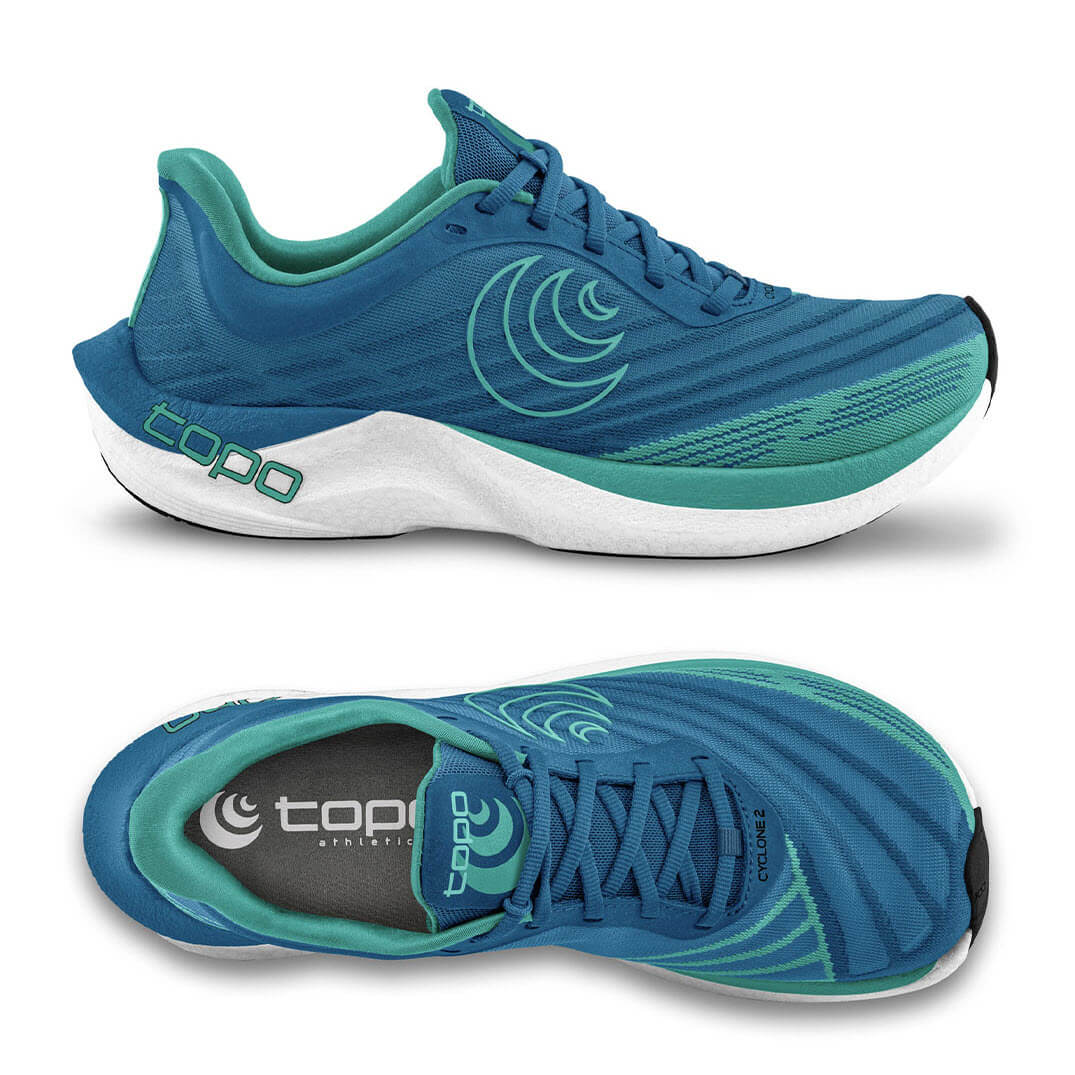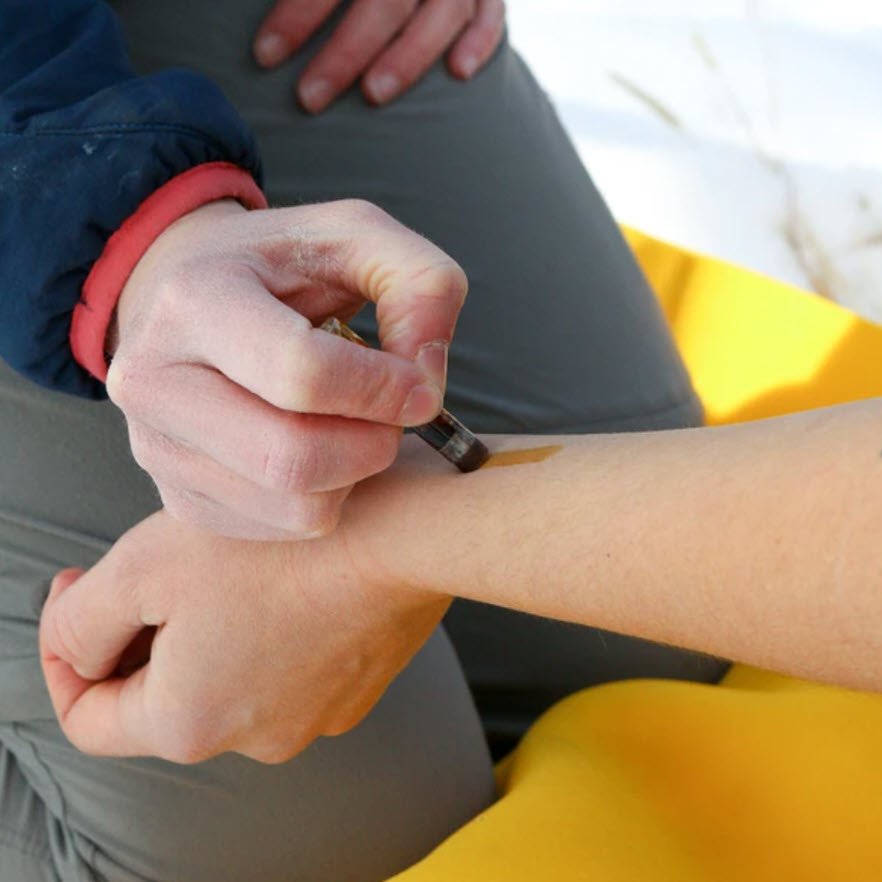As far as blisters are concerned, your choice of sock is a rather important one. Socks are the very things that contact your skin, after all. As a result, they have the potential to irritate or even increase blister formation over the foot, such is their coverage area. So, let’s consider blister prevention socks in detail.
First, we'll cover the important function of moisture-management. Secondly, we’ll look at the extra layer that comes with double-socks, including toe-socks. Then we'll look at a feature of blister prevention socks you may have overlooked - the thickness of socks. Lastly, we’ll stand back and have a good look at whether our expectations of anti-blister socks are realistic.
MOISTURE-MANAGEMENT
Hydrophilic vs hydrophobic
Sock yarns or fibres are either water-attracting (hydrophilic) or water-repelling (hydrophobic). This focus on moisture-management is reasonable when you consider how much the feet perspire, especially with exercise, and the potential for water to enter the sock from the outside environment1. Of course, soggy socks are something to avoid. The focus on moisture-management is a focus on friction levels. So, let’s quickly refresh our memory on how friction causes blisters.
Yarns and Fibres
Natural yarns:
Natural yarns are hydrophilic - cotton especially so. It holds moisture against the skin. Wool is hydrophilic too. However, it performs much better than cotton, particularly Merino wool. Compared to other sheep wool, Merino which has a finer core diameter of each fibre, giving it a softer feel and more air space for moisture management2. Wool is also known for its thermal insulation. Bamboo is the new kid on the block. There is no research on this natural yarn for socks in the wilderness or athletic arenas to know how it performs with moisture-management. However, anecdotally, bamboo socks are comfortable but take a long time to air-dry.
Synthetic fibres:
Synthetic fibres are hydrophobic. They include acrylic, polyester and polypropylene. Synthetic fibres repel water making them quick-drying, plus they provide better cushioning when wet and hold their shape better when wet. Material testing research that showed that when wet, acrylic fibres swelled 5%, wool 35% and cotton 45%1. All in all, synthetic fibres are also more durable than natural yarns.
Blends:
Combinations of water-resistance, wicking, thermal insulation, wind resistance, anti-microbial resistance, reduced weight, cushioning and resiliency, reduced coefficient of friction (COF), durability, maintenance of shape when wet, machine washable, quick drying and odour resistance are required in certain environments2. This combination of properties is achieved through the thoughtful mixture of natural yarns and synthetic fibres to make what’s known as blend socks. Comparing a polypropylene synthetic sock with a blend sock (99.6% polypropylene and 0.4% elastane versus 50% merino wool, 33% polypropylene and 17% polyamide) Bogerd3 found the blend sock to be more comfortable in a military setting in terms of being cooler, less damp and overall more comfortable (although interestingly, not the subjective assessment of “friction”). Yet the blend stored almost 3 times as much water.
BLISTER PREVENTION SOCK TYPE
1. Moisture-wicking Socks
Now, let’s look at the most common type of blend sock that deals with moisture-management: Moisture-wicking socks.
How they work:
Moisture-wicking socks work by encouraging moisture to move away from the skin. More specifically, the wicking gradient facilitates the transportation of moisture throughout the sock. The larger the surface area of moisture in the sock, the more likely it is to spread throughout the sock so it can escape via evaporation through the shoe upper.
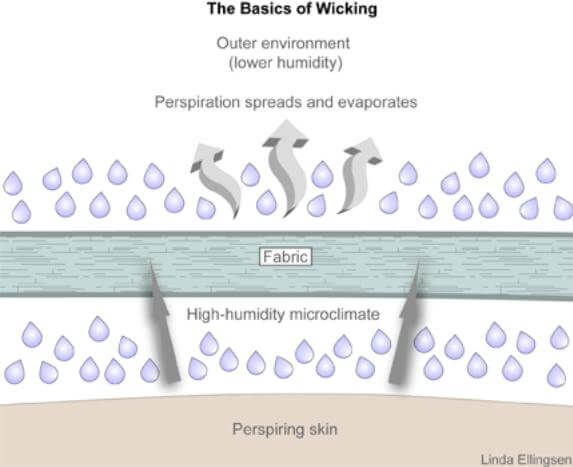 p
pBlister prevention socks that are moisture-wicking rely on a moisture gradient to move moisture away from the skin
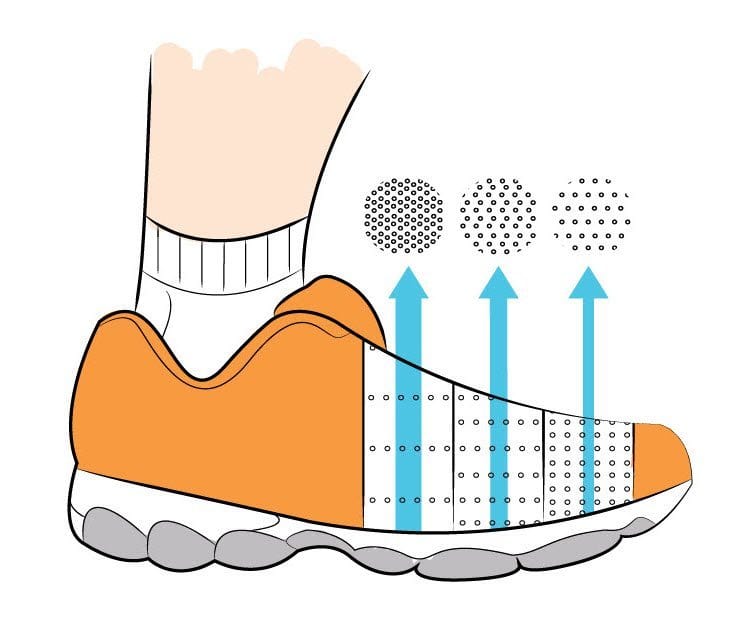 p
p
Moisture-wicking socks rely on ventilation through the shoe upper to work optimally
Research:
When we exercise, things get hot in our shoe. Obviously, higher temperatures cause more perspiration4. And of course, faster walking speeds increase in-shoe temperatures5,6 and increased sweating.7 This perspiration provides the ‘moist’ environment known to increase friction levels 8–11 and blister formation.12,13 So, the drier our socks can keep our feet, the less likely we are to get blisters thanks to lower friction levels.
But how do lower friction levels reduce blister formation? Remember, blisters are a tear under the skin surface caused by the skin and bone moving out of sync14. As the bones move within the foot with each step, the skin does not follow – when there are high friction conditions in the shoe. As a result, the soft tissues in between are made to stretch and distort. This is called a shear distortion and it happens with every step.
If these shear distortions are too high in magnitude, a tear develops under the skin surface which soon fills with fluid to become a blister. Therefore, blister prevention aims to reduce the skin and bones from moving out of sync. One way to do this is to reduce friction levels. The lower the friction level, the sooner the skin can move along with the underlying bone, thereby reducing the magnitude of the soft tissue shear distortion. This is how moisture-wicking socks aim to work: drier skin = lower friction = smaller shear distortions = less likely to blister.
Pros:
Moisture-wicking socks work for blisters over the whole foot, except interdigital blisters where the sock is not in contact with the skin.
Cons:
Moisture-management is limited by the shoe-upper’s ability to allow evaporation.
Learn more:
I’ve written at length about moisture-wicking socks so I encourage you to read this article if you’d like to learn more.
Popular brands:
CoolMax is a fibre used by many sock brands, like Injinji, Bridgedale and Darn Tough. Other brands have their own proprietary moisture-wicking fibres, like Wigwam with “Ultimax Fusion”, Balega with “Mohair and Drynamix” and Feetures with “iWick”.
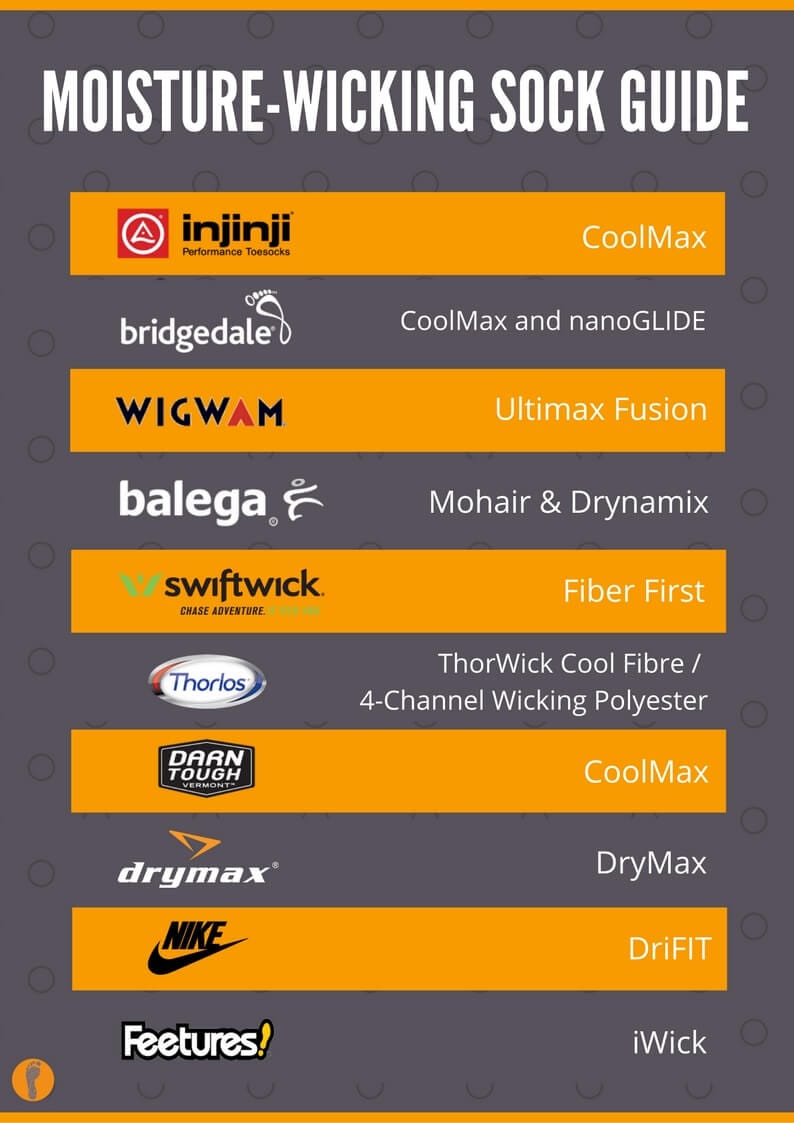 p
pMoisture-wicking blister prevention socks guide
Note: Where is friction highest in a single sock scenario?
Socks have the potential to reduce friction levels at either the skin-sock interface; or the sock-shoe interface. Perhaps because it has been demonstrated by Sanders15 that skin-sock friction is higher, most blister prevention strategies tend to focus on this interface. In this way, just think of powders, lubricants, tapes, moleskin – they all work at the skin-sock interface. Certainly Dai16 demonstrated that wearing a sock with low friction against the foot skin was found to be more effective in reducing plantar shear force on the skin than the sock with low friction against the insole. Double-socks, however, introduce an additional interface, the sock-sock interface.
BLISTER PREVENTION SOCK TYPE 2: Double Layer Socks
Double-socks usually consist of two distinct socks, one worn over the other. Each sock is made from different materials. However, some are a single sock with two layers of material built in to it that are able to move independently of one another.
How they work:
Double-socks also work by reducing friction levels. They work on the premise that there is a low friction level between the two socks compared to if there was just one socks. In this way, it relies on the strategic choice of the materials. They’re usually different. The inner sock is usually a thin synthetic material. With this lower sock-sock friction level, a small early glide is able to occur sooner between the socks. As a result, the skin is able to move more in sync with the bone. Shear distortions are lower because the two socks can move against one another easily (sooner) allowing the skin to move more in sync with the bone.
Additionally, they almost always exhibit a wicking gradient, making them moisture-wicking socks as well. Understandably, it depends on the specifics of the sock combination. The combination that provides the wicking gradient always involves a thin synthetic inner sock against the skin.
Richie1 mentions that double socks create a movement interface, either within the sock itself or between the sock layers. Reducing the friction force on the skin is best achieved with synthetic socks.
Research:
US military testing by Robertson and Christopherson in 1994 found that adding a CoolMax inner sock significantly reduced blisters compared to a single sock, even when that single sock was of thick construction1.
Somewhat surprisingly, Knapik17 found a standard military sock (wool + cotton + nylon + Spandex) on the outside and a polyester Coolmax inner sock produced more blisters than the standard military sock alone (77% vs 69%). However, the blisters that did result were less severe with the CoolMax double-sock condition.
Jagoda18 may have confirmed a liner sock plus padded outer sock as beneficial over single sock in US marine recruits following a 6-mile hike. However, the addition of powder (Desenex) to the skin for two of the sock conditions do muddy the waters on this conclusion. They also found the effect of the sock/powder conditions depended on the hair colour of the participants, which was taken as an indication of their skin colour. They found that fair-haired persons were better off wearing a nylon dress sock under a white athletic sock, while dark-haired persons were better off wearing a white athletic sock under a green standard marine issue green sock.
Pros:
Double-socks have the potential to work for blisters over the whole foot, except interdigital blisters where the sock has no contact with the skin.
Cons:
Two pairs of socks add to the bulk and can make the shoes too tight, particularly in the toe box.
Popular brands:
Wrightsocks are a single sock with double layers constructed into the forefoot/toes and heel. In contrast, Armaskin socks are a single sock as the inner sock, and you can wear any sock as the outer sock. Armaskin are quite unique in that the friction level against the skin is extremely high – you can’t actually pull them on like a normal sock, you have to roll them on. Yet I believe they are the most effective double-sock available.
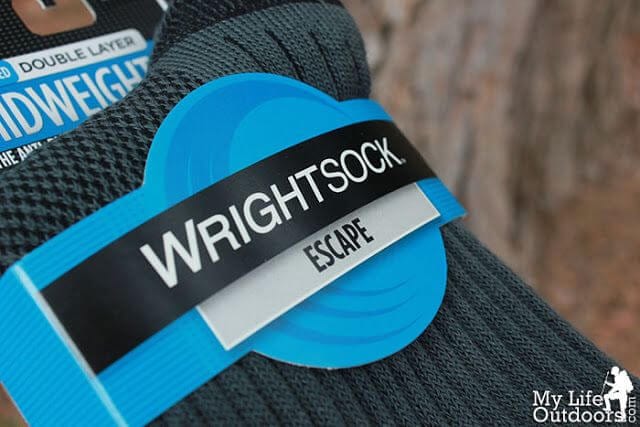 p
pWrightsocks are a popular double sock system where there are two layers of sock in certain spots.
Learn more:
I’ve written at length about double-socks so I encourage you to read that article if you’d like to learn more.
BLISTER PREVENTION SOCK TYPE 3: Toe-socks
Anecdotally, toe-socks are popular among runners and hikers, particularly those who suffer toe blisters. However, there is very little research on how effective they are.
How they work:
Toe-socks are an interesting version of a double-sock, but only for the interdigital spaces. They’re unique in that they replace the skin-skin surface between the toes to a sock-sock surface between the toes. However, double socks usually work by combining two different materials to move against one another. When it comes to toe-socks, it’s the same material throughout. Toe-socks do separate and cushion the interdigital space compared to any other type of sock. Thick toe socks will provide more separation and pressure reduction compared to thin, but only if there is enough room in the toe box of the shoe.
Research:
There is very little research on the effectiveness of toe-socks, or even much commentary on their mechanism of action. Although, there is a little. Toe-socks result in less interdigital maceration. However, objective measures of skin hydration and blister incidence showed no difference compared to a standard issue military socks.19 Lipman20 found the combination of toe-socks and toe taping with paper tape actually increases blister incidence.
Pros:
Toe-socks are the only sock that has the potential to prevent interdigital blisters and should be considered as blister prevention socks for these blisters.
Cons:
They aren’t any better than a normal sock for all other areas of the foot. The double layer in each interdigital space can significantly increase bulk in the toebox and make it too tight. There is no research on the effectiveness of toe-socks
Popular brands:
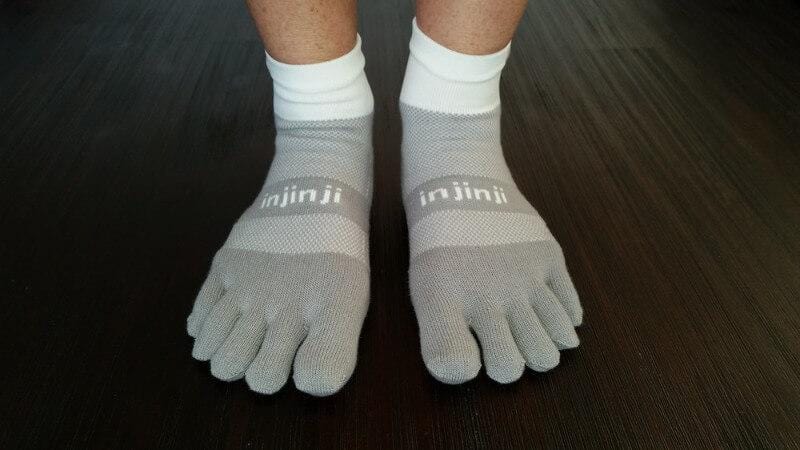 p
pToe-socks help prevent interdigital blisters
Learn more:
I chatted with Paul Reuss from Injinji Performance Products and encourage you to read that article before you purchase your next pair of Injinji toesocks.
BONUS FEATURE OF ANTI-BLISTER SOCKS: Thickness
How they work:
Thick socks can potentially reduce blister formation by absorbing shear forces. In other words, the thick nap of the sock undergoes some shear distortion meaning the skin doesn’t have to. Again, this allows the skin to move more in sync with the bone as it moves back and forth within the foot with every step we take.
Research:
Research shows thicker socks reduce the chance of blisters and can be considered as a blister prevention sock feature. In 1990, Herring and Richie21 tested 100% cotton socks with 100% acrylic socks, otherwise identical in construction which included “padding” features, on a group of 35 long distance runners. The acrylic were associated with fewer blisters and smaller blisters.
It would be easy to put this down to the superiority of synthetic over cotton. However, the researchers followed it up22 to find out if the protective effect of the acrylic socks was retained (over cotton) when the padding was removed. So, the conclusion was, the thicker, densely padded socks enhance the effectiveness of the acrylic fibres compared with cotton. The mechanism could be the increased moisture-wicking effect available when the sock is thicker. However, it could also be to the additional blister prevention mechanism of “shear absorption”. The thick nap of the sock absorbs shear distortions, so soft tissues of the foot shear less. Knapik,17 Thompson23 and Herring22 have described this mechanism of blister prevention.
Other research17 compared blister rates with different socks and found a very dense prototype outer sock (wool + polypropylene) with a CoolMax polyester inner sock reduced both the overall incidence and severity of blisters, compared to a standard military sock alone (wool + cotton + nylon + Spandex), and compared to the combination of the standard military outer sock and CoolMax polyester inner sock.
Similarly, Van Tiggelen24 found that in basic military training, a single padded polyester sock (88% polyester, 11% polyamide, and 1% elastine) provided more blister prevention than the standard issue army socks (70% combing wool and 30% polyamide) and double-layer socks (inner = 45% polyester, 45% viscose, 8% polyamide, and 2% elastane; outer = 40% cotton, 40% wool, 18% polyamide, and 2% elastane).
Pros:
Thick socks could work for blisters over the whole foot, except between the toes where the sock has no contact (except if they are toe-socks, of course.
Cons:
If the thickness of the sock negatively impacts the fit of the shoe, making it too tight, any blister protective effect may be over-ridden by the increase in pressure.
Popular brands:
While almost every sock brand makes socks that are thicker than others in their range, Thorlo Experia are a good example of socks with “anatomical padding” – padding around the heels, forefoot and toes.
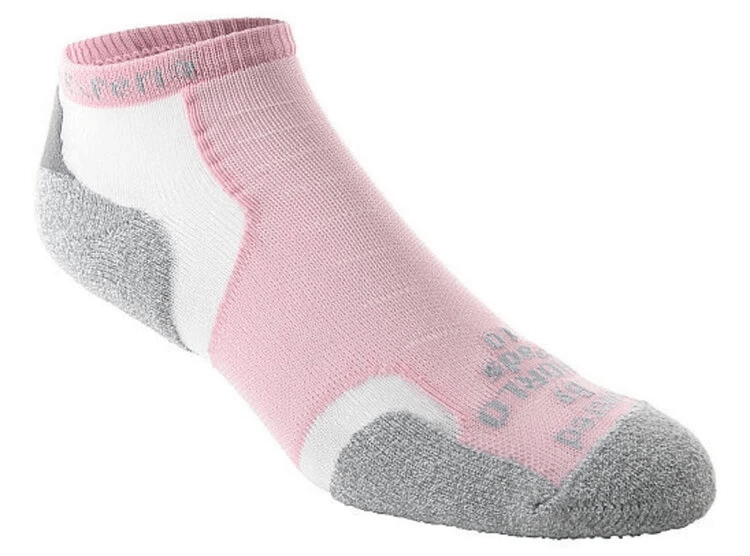 p
p
Thorlo Experia socks exhibit anatomical padding and can be considered as blister prevention socks.
Your expectations of anti-blister socks
Is it realistic to expect a sock to completely eliminate blister formation? Take a look at the research. Even the best results showed blisters still occurred, albeit less often. Additionally, take a good look at the pros and cons. Most socks don't actually cover the whole foot; traditionally-shaped socks don't have any contact with the interdigital spaces so have no chance of preventing blisters between the toes. And when you consider blisters under the toenails, these usually have nothing to do with socks or moisture-management; they are all about pressure on the end of the toenail.
My advice to you is to understand the function of socks and milk every bit of blister prevention out of your choice of sock. But, understand a sock's ability to provide targeted blister prevention is limited. Your task then is to find a more targeted blister prevention strategy for your particular blister according to its anatomical location.
References
- Richie D. Therapeutic hosiery: an essential component of footwear for the pathologic foot. Pod Manag. 2013;(October):155-162. Accessed December 13, 2020. https://www.podiatrym.com/cme/CME1013.pdf
- Richie D. Athletic Footwear and Orthoses in Sports Medicine. Chapter 7: Athletic Socks. (Werd M, Knight E, eds.). Springer; 2010. doi:10.1007/978-0-387-76416-0
- Bogerd CP, Niedermann R, Brühwiler PA, Rossi RM. The effect of two sock fabrics on perception and physiological parameters associated with blister incidence: A field study. Ann Occup Hyg. 2012;56(4):481-488. doi:10.1093/annhyg/mer127
- Dawson CA, Bancells RL, Ebel B, Bergfeld WF, Mcfarland EG. Treatment of Friction Blisters in Professional Baseball Players. Vol 9.; 2004.
- Covill D, Guan Z, Bailey M, Pope D. Effects Of Varying The Environmental Conditions On In-Shoe Temperature. In: Proceedings of the ISB Symposium on Footwear Biomechanics. ; 2003.
- Hall M, Shurr D, Zimmerman B, Saltzman C. Plantar Foot Surface Temperatures With Use Of Insoles. Iowa Orthop J. 2004;24:72-75.
- Deng F, Gong T, Jin H, Du S. Research on Factors Influencing Temperature and Relative Humidity Inside of Shoes.
- Naylor PFD. The skin surface and friction. Br J Dermatol. 1955;67:239-248.
- Akers WA, Sulzberger MB. The Friction Blister. Mil Med. 1972;137(1):1-7.
- Nacht S, Close J-A, Yeung D, Gans EH. Skin friction coefficient: changes induced by skin hydration and emollient application and correlation with perceived skin feel. J Soc Cosmet Chem. 1981;32:55-65.
- El-Shimi AF. In vivo skin friction measurements. J Soc Cosmet Chem. 1977;(28):37-51.
- Naylor PFD. Experimental friction blisters. Br J Dermatol. 1955;(67):327–42.
- Kirkham S, Lam S, Nester C, Hashmi F. The effect of hydration on the risk of friction blister formation on the heel of the foot. Ski Res Technol. 2014;20(2):246-253. doi:10.1111/srt.12136
- Richie D. How To Manage Friction Blisters. Pod Today. 2010;23(6):42-49. https://www.podiatrytoday.com/how-to-manage-friction-blisters
- Sanders JE, Greve JM, Mitchell SB, Zachariah SG. Material properties of commonly-used interface materials and their static coefficients of friction with skin and socks. J Rehabil Res Dev. 1998;35(2):161-176.
- Dai XQ, Li Y, Zhang M, Cheung JTM. Effect of sock on biomechanical responses of foot during walking. Clin Biomech. 2006;21(3):314-321. doi:10.1016/j.clinbiomech.2005.10.002
- Knapik JJ, Hamlet MP, Thompson KJ, Jones BH. Influence of boot-sock systems on frequency and severity of foot blisters. Mil Med. 1996;161(10):594-598.
- Jagoda A, Madden H, Hinson CA. Friction blister prevention study in a population of marines. Mil Med. 1981;146(1):42-44.
- Koulutusohjelma J, Miikkola M, Numminiitty J. Sukkamateriaalien vaikutukset jalkaterien ihon kosteuteen ja varvasvälihautumiin Feelmax-varvassukat Kaartin Jääkärirykmentissä. Published online 2006.
- Lipman GS, Ellis MA, Lewis EJ, et al. A Prospective Randomized Blister Prevention Trial Assessing Paper Tape in Endurance Distances (Pre-TAPED). Wilderness Environ Med. 2014;25(4):457-461. doi:10.1016/j.wem.2014.06.013
- Herring KM, Richie DH. Friction blisters and sock fiber composition. A double-blind study. J Am Podiatr Med Assoc. 1990;80(2):63-71.
- Herring KM and Richie DH. Comparison of cotton and acrylic socks using a generic cushion sole design for runners. J Am Podiatr Med Assoc. 1993;83(9):515-522.
- Thompson KJ, Hamlet MP, Jones BH, Knapik JJ. Impact Of Sock Systems On Frequency And Severity Of Blister Injury In A Marine Recruit Population.; 1993.
- Van Tiggelen D, Wickes S, Coorevits P, Dumalin M, Witvrouw E. Sock systems to prevent foot blisters and the impact on overuse injuries of the knee joint. Mil Med. 2009;174(2):183-189.
